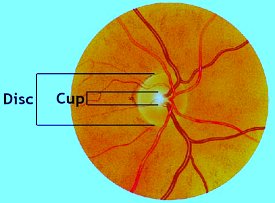Cup to Disc Ratio
 The cup-to-disc ratio is a measurement used in to determine the risk or progression of glaucoma. The optic disc is the anatomical location where the optic nerve and blood vessels enter the retina. Looking into the eye through the pupil the optic disc appears as a yellowish/pink circle or oval. In the centre of the optic disc is a whitish area, know a the cup.
The cup-to-disc ratio is a measurement used in to determine the risk or progression of glaucoma. The optic disc is the anatomical location where the optic nerve and blood vessels enter the retina. Looking into the eye through the pupil the optic disc appears as a yellowish/pink circle or oval. In the centre of the optic disc is a whitish area, know a the cup.
If one could see the optic disc in 3D the cup would look excavated, like someone had scooped out some of it with an icecream scoop.
http://youtu.be/m65Xj0D7ldc
The cup-to-disc ratio compares the diameter of the “cup” portion of the optic disc with the total diameter of the optic disc. A good analogy to better understand the cup-to-disc ratio is the ratio of a donut hole to a donut. The hole represents the cup and the surrounding area the disc. If the cup fills 1/10 of the disc, the ratio will be 0.1. If it fills 7/10 of the disc, the ratio is 0.7. A large cup-to-disc ratio may be due to glaucoma or someone could just naturally have a large cup-to-disc ratio.
In glaucomaan increase in intra-ocular pressure will damage the delicate nerve fibres and produces additional cupping of the optic disc. As glaucoma advances, the cup enlarges until it occupies most of the disc area.
The average person has a cup-to-disc ratio of less than 0.5. If the cup-to-disc ratio increases or is larger than average, further tests should be performed to rule out the risk for glaucoma.
Michael D. Nelson, OD


